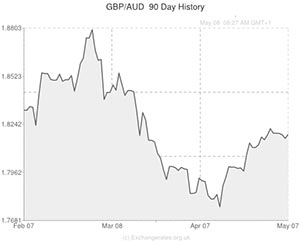
The AUD to GBP Exchange Rate advanced to its best level in over a week after positive domestic employment data combined with a better-than-expected trade report out of China, Australia’s biggest trading partner.
Against the US Dollar the ‘Aussie’ is trading at its best level in three weeks.
The currency rallied after official data released by the Australian Statistics Bureau showed that the number of people in work across the country climbed by 14,200 in April, beating economist forecasts for an increase of 6,000.
Adding to the positive report was the revision upwards of March’s data to 22,000 from 18,100.
The South Pacific nation’s unemployment remained steady at 5.8%, beating expectations for it to edge higher to 5.9%.
“Job growth has been solid over the past couple of months. In fact a total of 106,000 new jobs have been created since the start of 2014- marking the best start to a calendar year in six years. There is no question that the economy has lifted and it is pretty clear that the transition in activity from mining to housing construction has been a case of so far so good and more importantly housing construction is supporting the recent rise in employment,” said an economist from CommSec.
Also adding support to the currency was trade data out of China which showed that both imports and exports in the world’s second largest economy improved in April.
Exports rose by 0.9% from the previous year, smashing forecasts for expected decline of 3%. Imports increased by 0.8% giving the nation a trade surplus of $18.46 billion.
The Pound meanwhile was trading at multi-week highs against the Euro and multi-year highs against the US Dollar as investors await today’s Bank of England policy decision.
Pound to Australian Dollar update – 08/05/2014
The Pound softened against its South Pacific rival after Australian employment data showed a stronger-than-expected jobs gain.
Chinese trade figures revealed an unexpected increase in imports and exports, further boosting the commodity-driven Australian Dollar against Sterling.
The GBP to AUD pairing largely retained declines during the European session as the Bank of England acted as economists expected.
The central bank refrained from issuing one of its rare policy statements and left the benchmark interest rate at the historic low of 0.50 per cent.
The pace of asset purchases was also left unaltered.
Although recent economic reports for the UK (including this week’s impressive services PMI) are indicative of a broad-based recovery, the BoE remains concerned about the amount of slack in the economy.
The BoE’s decision prompted this response from economist Alan Clarke; ‘Inflation means there’s not a huge amount of pressure to hike rates. The forecasts will be similar to February, and though the data will be nudging them in a hawkish direction we won’t see a dissenting vote for a rate increase soon’.
Economists are projecting that a rate increase is unlikely to occur before the first quarter of next year.
With the Reserve Bank of Australia’s monetary policy statement due for publication at 02:30 GMT, further Pound to Australian Dollar fluctuations could occur before the weekend.
Australian Dollar (AUD) Exchange Rates
[table width=”100%” colwidth=”50|50|50|50|50″ colalign=”left|left|left|left|left”]
Currency, ,Currency,Rate ,
Australian Dollar, ,US Dollar, 0.9383,
,US Dollar, 0.9383,
Australian Dollar, ,Euro, 0.6734,
,Euro, 0.6734,
Australian Dollar, ,Pound, 0.5531,
,Pound, 0.5531,
Australian Dollar, ,New Zealand Dollar, 1.0832,
,New Zealand Dollar, 1.0832,
US Dollar, ,Australian Dollar, 1.0660,
,Australian Dollar, 1.0660,
Euro, ,Australian Dollar, 1.4848,
,Australian Dollar, 1.4848,
Pound Sterling, ,Australian Dollar, 1.8079,
,Australian Dollar, 1.8079,
New Zealand Dollar, ,Australian Dollar, 0.9232,
,Australian Dollar, 0.9232,
[/table]
[/table]

Comments are closed.